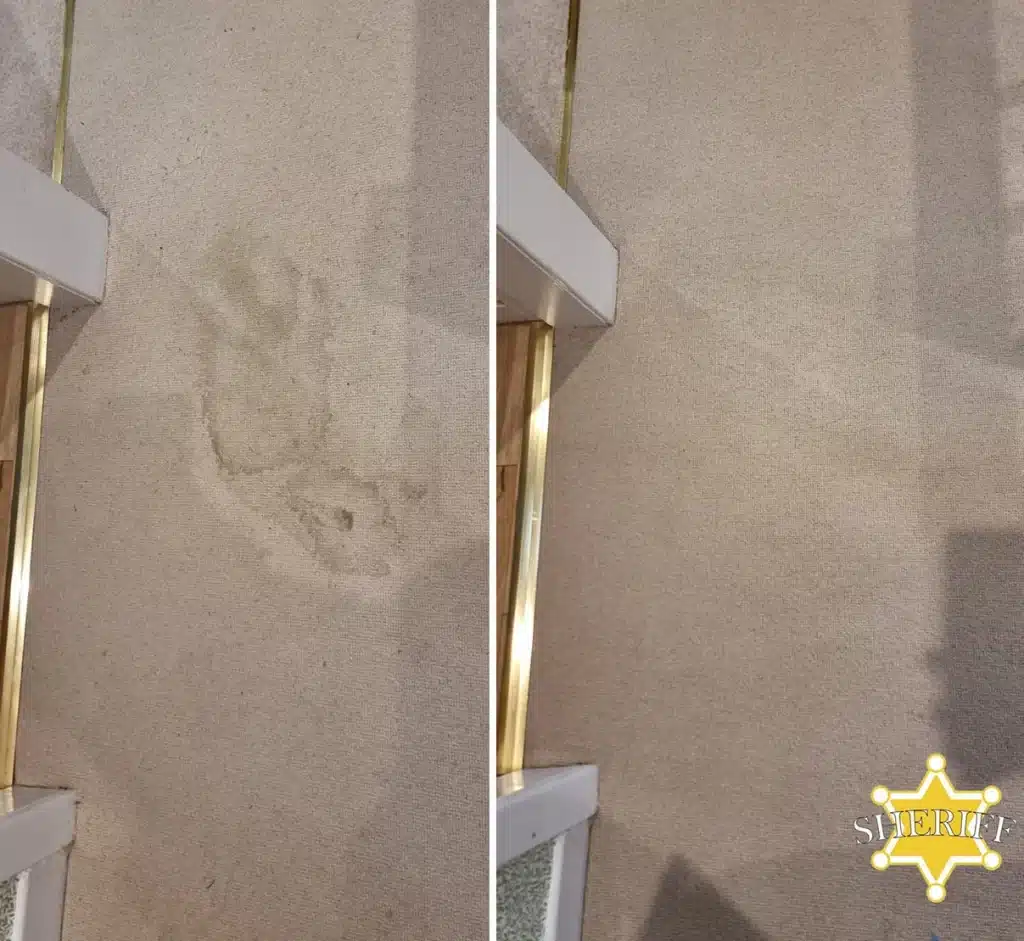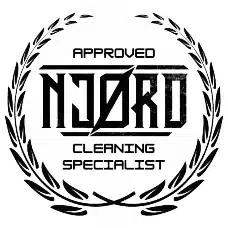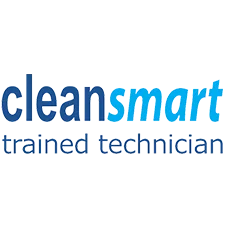WoolSafe Advice - How Properly Treat Wool Carpets & Rugs
Spot & Stain Removal
General Advice
- As a first step, do not panic, but act quickly as the removal of fresh spots is always much more successful than of old stains.
- Decide whether you can tackle the removal yourself (with the help of this guide). In case of extensive or old, set-in stains, contact your nearest WoolSafe Approved Service Provider.
- Always take up as much of the soil/stain as possible before applying any WoolSafe Approved spot remover.
- Before applying any spotting agent, pre-test it on an inconspicuous area of the carpet.
- Always apply the spotting agent on a cloth, not directly on the stain. Wear rubber gloves.
- Never use washing up liquid or other cleaning agents not intended for carpet as they leave sticky residues and cause rapid soiling.
- Use small quantities of spot remover at a time, repeat if necessary. 2 or 3 light applications are more effective than 1 drastic application. Do not over wet the carpet.
- Always work from the edge of the stain towards the middle to avoid spreading it. Blot, never rub.
- Use solvents with care and ensure good ventilation.
- Always thoroughly rinse out water-based spotters with clean water.
For simple steps on how to remove common household spills:
Watch these 1 minute videos…
Soiling prevention
There are two main types of soil (dirt):
Type 1 coarse, dry, heavy soil like sand and grit which can be removed by vacuuming.
Type 2 fine, sticky, lightweight soil like soot, oil from air pollution. This soil is removed using one of a variety of cleaning solutions and systems.
Dirt particles carried into your home or work premises on the soles of shoes or by air currents are deposited on the carpet surface and stick to the pile fibre making your carpet appear dirty.
The more your carpets and rugs soil, the more difficult and often expensive, it becomes to clean them. So, it makes sense to minimize the rate at which your carpet gets dirty by reducing the amount of soil reaching the carpet.
Some simple preventative steps are:
Place barrier mats outside all entrances (removes coarse mud and grit).
Place absorbent mats inside (removes light soils and water)
Take off muddy or wet shoes at the door.
Rug Padding – A quality pad used under your rug helps protect it from damage, wear and slippage. Every rug needs one. For a flat weave, use rubber waffle pad and for a thick hand knotted or tufted, use rubber backed synthetic felt. Always replace the pad if the rug has had pet contamination.
Vacuuming
Regular vacuuming will extend the life of your carpet and contribute to maintaining its great appearance.
Vacuuming should be proportional to the amount of soiling to which the carpet is subjected – the more adults, children and pets you have walking and playing on the carpet, the more often you are advised to vacuum.
For the average household it is good practice to vacuum daily in high traffic areas such as hallways, near entrances or busy living spaces and 2 or 3 times a week for the rest of your home.
For a thorough vacuum do three or four passes in each direction (North-South and East-West).
As a general rule it is advised to use an upright, brush assisted vacuum for cut pile and suction only vacuum cleaner on loop pile carpet and rugs.
Vacuuming Rugs – Like most carpeting, rugs should be vacuumed at least weekly to remove dry soil, lint, and hair. If in an entryway, vacuum more often. Be cautious not to vacuum the fringe with your brush bar! Use the end of a vacuum hose from a canister vacuum. Every few months turn the rug face down on a clean, dry smooth surface and vacuum to vibrate out the embedded dry soil.
Rotation – To ensure even wear, your rug should be rotated. Depending on the traffic, the rotation may vary from every six months to once a year.
Protection
There are two main reasons for choosing to treat your carpet or rug with a protector.
Stain Protection: To give additional time for you to clean up a spill before it penetrates the fibers of your carpet or rug.
Soil Retardancy: To slow down the rate at which your carpet or rug gets dirty.
Make sure that the protector you select is WoolSafe Approved and that a qualified and Approved Service Provider is employed to carry out the application of the protective treatment. If a protector is over-applied it may cause rapid soiling and if it is under-applied it may not be as effective as it should be.
It is very important to check the carpet or rug manufacturer’s warranty conditions before applying a protector as some manufacturers state that to do so may void the warranty.
Professional Cleaning
Carpet cleaning is an unregulated business. Anyone can buy a carpet cleaning machine and, without any training or experience, start advertising themselves as a professional carpet and rug cleaner.
Even some reputable carpet cleaners may not have the training or knowledge of the special techniques and chemistry required for safe and effective cleaning of wool and other fine fibre flooring .
So how do you know who to trust with your valuable carpets and rugs?
When looking for a suitable service provider ask for training certificates (related to cleaning fine fibre carpets and rugs), accreditations and membership of reputable industry associations or organisations.
To be sure that you get a professional who really understands how to clean wool and other fine fibres entrust the work to a WoolSafe Approved Service Provider. These professional carpet and rug cleaners are fully trained and accredited WoolSafe Fibre Care Specialists, have many years of experience and they will only use WoolSafe Approved cleaning products on your natural fibre carpets and rugs!
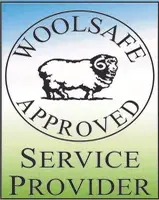
If you are considering cleaning the carpet or rug yourself make sure to use only WoolSafe approved products. Look for the Certification Mark on the bottle or package.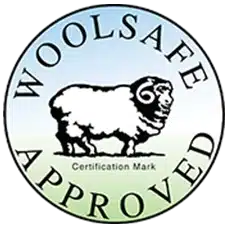
WoolSafe approved products have been independently and scientifically tested and are safe and effective for cleaning and maintaining wool and wool-rich carpets and rugs.
Never use any detergents such as dish washing liquids, soaps or other cleaners recommended for general household use. Although they may clean spills or dirt from your carpet initially, they will almost certainly cause problems such as rapid soiling, colour bleeding or other damage to the pile or backing of the carpet.
There are two main methods of DIY carpet cleaning:
Low moisture cleaning – dry compound or encapsulation
Hot water extraction (also referred to as wet cleaning or ‘steam cleaning’)
Dry compound cleaning is very low risk as there is no danger of over-wetting the carpet, causing shrinkage or long drying times. Carpets and rugs can be walked on almost immediately. This method is most suitable when done regularly, keeping a consistently high level of appearance for your carpets and rugs.
If the carpet is cleaned less regularly or there is high footfall you may wish to use the hot water extraction method.
Here are some cleaning guidelines for you to follow:
Thoroughly vacuum the carpet.
Pre-test the carpet or rug in an inconspicuous area with a small amount of the cleaning solution you are going to use. Look for any change in colour or texture. Dab with a tissue to see if there is any dye transfer.
Pre-treat any spots and spills (see stain wizard, spot removal videos or download the free WoolSafe stain guide app).
Apply the cleaning solution or compound and gently agitate it into the pile.
Allow 5-10 minutes for the solution to loosen the dirt from the fibres.
Rinse with a WoolSafe Approved solution or plain water (wet clean method) or vacuum away the compound once dry (low moisture methods).
Set the pile in one direction (Usually in the direction of the ‘natural’ pile lay).
Allow time for the carpet to completely dry before walking on it or replacing furniture.
What not to do…
Do not use products that are not formulated for carpets e.g. hard floor cleaners, bleach, dish washing liquids, bicarbonate of soda, salt, white wine or any other concoctions.
Do not over wet the carpet. Resist the temptation to go over heavily soiled areas again and again. This can lead to extended drying times (even mould), shrinkage, delamination of the carpet backing, damage to subfloors etc.
Do not scrub the carpet too aggressively. This can lead to permanent pile distortion, change in appearance, felting and loss of twist definition in cut pile carpets and ‘fuzzing’ in loop pile carpets.
Do not replace furniture before the carpet is dry. This can lead to rust marks from metal studs under the furniture’s legs or permanent marking from wood stain, varnish etc.
Fibre loss
Many new carpets, particularly those with a cut or velour pile, lose fibre during the first few weeks on the floor. This “shedding” is caused by the way the yarn is spun and how the carpet is made. It is no reason for alarm, but a natural phenomenon which will decrease over the first few weeks and eventually stop all together. Just vacuum the carpet as normal and empty the dust bag or receptacle regularly.
Pile Reversal
Pile reversal, also known as shading or – wrongly – water marking or pooling (water is not the cause), is the effect whereby areas of velour or velvet carpet appear to become lighter or darker in colour than the surrounding area. It is an optical effect, brought about by localised changes in the direction of pile lay and made visible by the way light is reflected off the carpet surface. It is caused by traffic patterns or unevenness in the floor, but is NOT a carpet defect. Loop pile carpets are not affected by this.
Sprouting
Occasionally tufts may appear above the surface of the carpet. Do NOT pull them out, but cut them level with the surrounding tufts with small scissors.
Colour change
The carpet may change colour over time for a variety of reasons, often due to pile flattening or gradual soiling. A good professional cleaning will usually restore the carpet’s appearance.
Very light-coloured – beige and cream – wool carpets may brighten in colour in the first few weeks, particularly near windows and patio doors. It will be most obvious if you move a piece of furniture and notice the carpet appears yellower underneath. It’s not that the carpet has yellowed, just that the natural creamy colour of the wool has ‘photo-bleached’. If you leave the ‘yellow’ part exposed it will quickly change to the same shade as the surrounding carpet.
Darker, dyed carpets will eventually fade when exposed for a long time to the ultraviolet rays in sunlight. The degree of fading depends on the shade and depth of colour chosen and the intensity of the light.
Indentations
It is advisable to put furniture cups under the legs of chairs, tables and cupboards to reduce indentations. If these have occurred on a wool carpet or rug lightly moisten the area and the indentation will disappear in 12 – 24 hours.
Atmospheric Soiling/Filtration Soiling/Draught marking
Carpets may show increased soiling around the edges of a room, under doors and near air ducts. This is called draught marking, fogging or filtration soiling, and is caused by the pile fibres filtering out dirt particles from the air blowing under skirting boards or doors, or from ducts. Ensure that these gaps are sealed before the carpet is installed.
If you need to speak to an expert about recent spillage or are looking for more detailed carpet and rug care advice then please call or email your local WoolSafe representative and they will be more than happy talk you through the best options open to you.
Head Office
49 Boroughgate
Otley, West Yorkshire
LS21 1AG, Great Britain
Tel: +44 1943 850 817
Email: office@woolsafe.org
WoolSafe North America
Director: Ms Ruth Travis
8631 East Otero Place,
Centennial,
CO 80112
Phone +1 615-972-0250
Email: Ruth@woolsafe.org
WoolSafe East Asia
Director: Tshun Peei Wong
41 – M Jalan Manis 3
Taman Segar, 56100
Kuala Lumpur, Malaysia
Phone: 1300-221-123
If calling from overseas: +603 9130 1034
Email: Peei@WoolSafe.org
WoolSafe China
Director: Jiang Huangzhou 蒋煌洲 (Firmin)
Building C, NO. 2888 QilianShan Road, Putuo District, Shanghai, China
上海市普陀区祁连山南路2888号C座
Contact Assistant to Director: Kastol Zhao 赵轶
Tel: +86 18964734465
Email: China@WoolSafe.org
WoolSafe Australia
Director: Colin Nation
PO box 158
Yandina
Queensland, 4561
Tel: 0408 966 500
Email: Australia@woolsafe.org
WoolSafe Southern Europe
Director: Dionysios Paraskevopoulos
Riga Feraiou 31,
15451 N. Psihiko,
Greece
Tel: +30 31 0674 6311
Email Dennis: parsak@otenet.gr

WoolSafe provides educational programmes, technical information and advice, and networks of highly skilled and experienced Service Providers and Registered Inspectors in different parts of the world.
Established in 1991, the WoolSafe Certification Mark is widely recognised in many parts of the world as the standard for excellence and safety of carpet care chemicals, both for professionals and consumers. It is used by many of the world’s largest cleaning product manufacturers and suppliers to identify and promote those carpet care products that are specifically suitable for use on wool and other natural fibres.
More recently WoolSafe introduced EnviroSeal, a testing and certification programme that identifies products that are not only safe and effective on wool carpets and rugs but safe for the environment too. 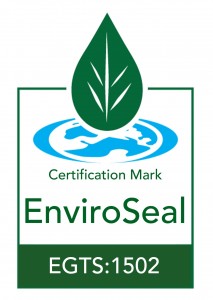
Source: www.woolsafe.org
Experience
prices
Reviews
customers
